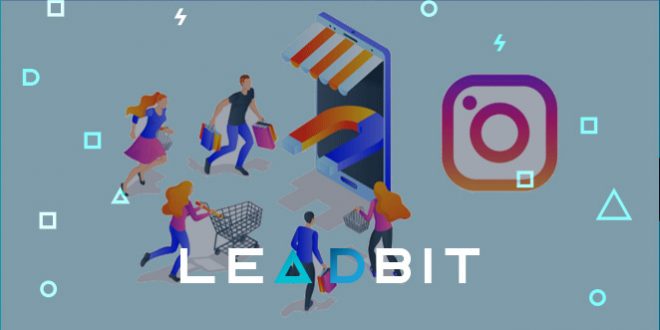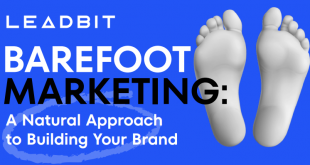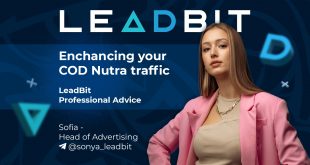We’re talking about Instagram again, but the topic of today’s review will be the cost of advertising on this social network. And in fact, we think this is the most important point. Don’t you believe it? It is very simple to prove this. The presence of a rubber budget allows you to promote any project on any site with a sufficient number of potential audience. That is, even if you absolutely do not understand targeting, you can simply bombard the audience with advertisements, take the number and sooner or later reach everyone. Buy naive posts from every influencer in the field, buy out the most expensive clicks in the most competitive areas. A lot of intelligence is not required for this. And what is required? That’s right, a lot of money. Such a campaign will cost millions of dollars, but, of course, it will not pay off.
Accordingly, it is important not only what advertising functions can be implemented in Instagram, but also how much it will cost. If one site shows results 20% better than another, but in the first one the same AC is implemented 30% cheaper, then it becomes not easy to determine the best option (in fact, it’s simple, if you have the skills of analysis, you will always be able to calculate the effectiveness if you have all the initial data).
The same review will introduce you to the main pricing factors in Instagram, as well as teach you how to save your advertising budget so that every cent invested is used with maximum efficiency.
Table of contents
- 1 Why it is worth sending an advertising budget to Instagram
- 2 The concept of the average price in Instagram
- 3 What does the cost of advertising on Instagram depend on
- 3.1 Type of advertisements, placement
- 3.2 Demographic factors of the audience on Instagram
- 3.3 Behavioral factors of the audience on Instagram
- 3.4 Payment model
- 3.5 Goals of AC on Instagram
- 3.6 Time of posting on Instagram
- 3.7 The influence of ad relevance on the cost per click on Instagram
- 3.8 Niche competitiveness on Instagram
- 4 Betting on Instagram
- 5 Advertising from influencers on Instagram
- 6 Tips for optimizing your Instagram budget
- 7 Example of basic analysis of AC for Instagram
- 8 Conclusion
Why it is worth sending an advertising budget to Instagram
Key indicators of the social network:
- 1 billion active visitors;
- 30% of the content in the top of user popularity is of an advertising nature;
- 90% of users are subscribed to more than one purely commercial project;
- There is almost parity between the female and male audience;
- More than 60% of the total audience are young people from 19 to 35 years old, who most often make purchases online.
These are well-known data, and yes, they show the site as a promising place for your AC. But what factors speak in plus about the price aspect of advertising on Instagram?
The concept of the average price in Instagram
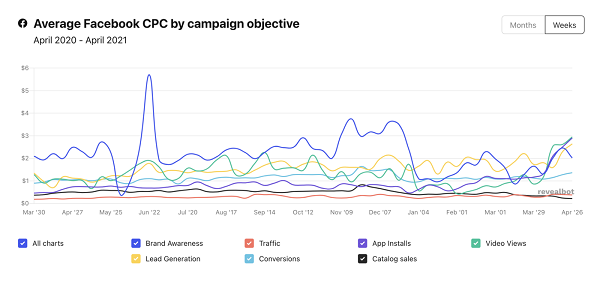
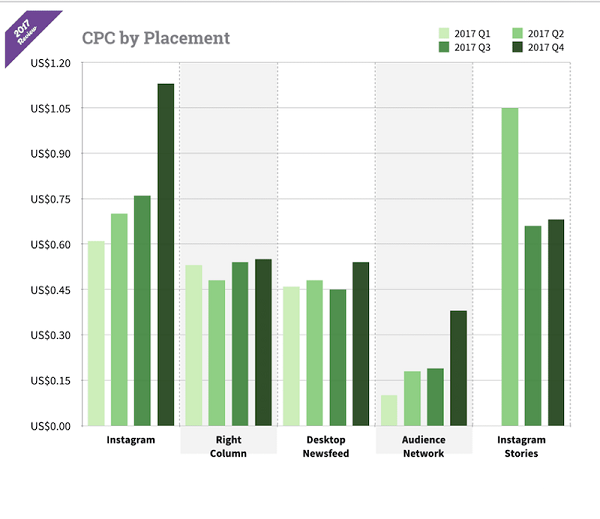
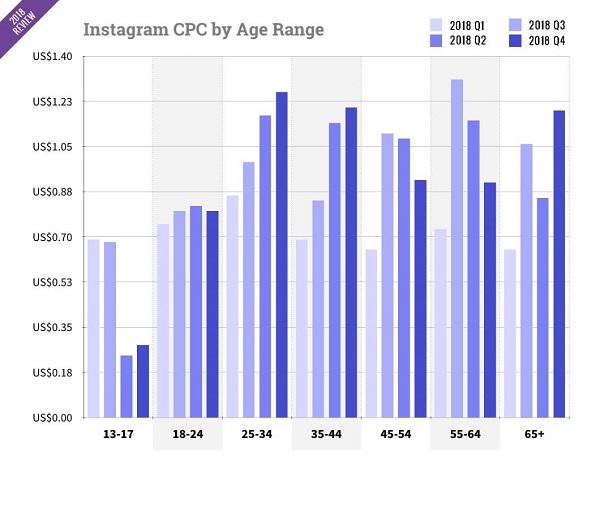
As can be seen from the graphs, the price factor varies greatly, depending on various parameters. And all these fluctuations together give rise to the concept of the average price. Yes, of course, you can simply highlight the most inexpensive goals, audience, placement and significantly reduce the cost of your AC. But if you start from the settings only based on the cost, the effectiveness of the campaign will be zero.
On the other hand, it would seem that the more expensive option can be avoided with general equals. After all, a theoretical offer can be suitable, for example, as an audience of 25-34, and 35-44. And the second one is cheaper. So can it target only her? This is also incorrect, because in this case, you will reduce the potential number of leads. And this, firstly, will increase competition for the remaining ones, which will increase the cost of advertising on Instagram. And secondly, the total number of potential leads will simply decrease. Therefore, if both audiences are suitable, then you need to target both groups.
So what does the concept of average price give us? Not much, actually. Now Instagram’s current average price is $0.7. And if it was lower than competitors before, now Instagram’s price is one of the highest. But the efficiency of the AC is also, so the price is quite balanced.
Currently, a AC on Instagram with identical parameters will cost more than in FB (although this superiority was achieved relatively recently), and also much more expensive than on Twitter, Pinterest or Quora. But the number of leads received will also be greater, so marketers choose Instagram.
The average cost per click on Instagram often does not correlate with the real average price. Why? The statistics are strongly influenced by affiliates who play by the “pipsing” method. That is, they optimize their AC for the cheapest audience, go for the minimum click. And they take quantity, not quality. One such affiliate is a way to redeem tens and hundreds of thousands of clicks in the conditions of a single AC. Let’s say $0.01 each. As a result, he alone will reduce the average price against hundreds of companies that focus on TIER 1 audience, buying clicks for $5-10. But they get hundreds of clicks, not hundreds of thousands.
What does the cost of advertising on Instagram depend on
To clearly understand how much a particular AC will cost, you need to form a budget in advance – you need to know what moments affect the cost of advertising on Instagram. Based on this knowledge, you will be able to reduce the cost of your campaign even at the preventive stage, without departing from the planned marketing techniques and the target audience. Work on small things that together can give a serious effect.
Type of advertisements, placement
Above, we have already paid attention to the chart showing price fluctuations depending on the placement. Indeed, the advertisement on stories are cheaper than the main Instagram feed. But this is if we abstract from the type. After all, in storis you can place both a static ad and a video ad or even a carousel of three videos. And the latter method will already be more expensive than regular advertising in the main feed.
That is, when choosing the type of advertisement, you need to look not only at the potential effectiveness, but also at the cost. After all, for example, in conditional version A – you get potentially 200 leads because you use an effective method of video advertising. And in case B (let’s assume) – only 100 leads, because you use static images. But in the first case, the AC will cost you $200 daily, and in the second – $85. Obviously, you will be able to keep this AC active for more than twice as long. Or create two parallel campaigns, and the budget will still remain.
In Instagram, unlike FB, there are only two placements – a regular feed and a story. The first one is more expensive. But there are much more types of advertising: one image, video, panorama and carousel in storis. It is obvious that the image is the cheapest, video is the second place, complex advertising is the most expensive.
Demographic factors of the audience on Instagram
One of the most important factors that affects the price more than others is your target audience. Even if you choose the most expensive format, but show your ad to 17-year-old Indians who do not have a permanent job and live in the province, the cost of advertising will still be low.
Remember that it is illogical to change the settings of the target audience based only on the cost. Even if your target audience is expensive, it will not cease to be yours. There is nothing to do, it means such an offer, such a product or service. Therefore, you can search for a similar audience, turn off some parts of your target audience (for example, cities) if they do not convert well and waste the budget in vain. But you can’t change the target audience.
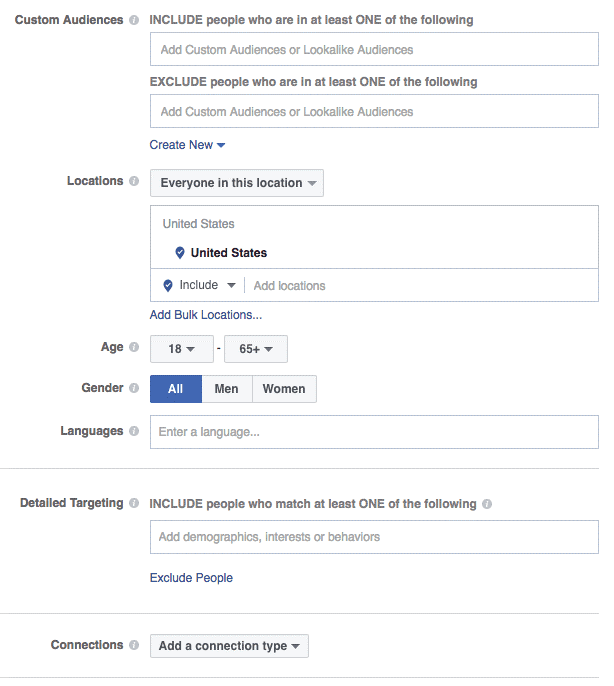
Let’s take a look at exactly which settings of targeting in Instagram affect the cost of ads. And yes, we can definitely identify specific settings and roughly indicate the direction of influence and level. But Instagram does not disclose the exact figures and percentages. All information is taken from the analysis of open statistics, including our own campaigns.
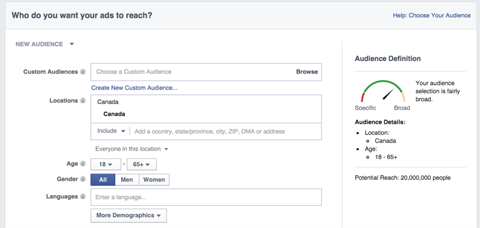
Also pay attention to the potential coverage, the arrow on the right panel of FB Ads Manager. It allows you to assess how much your settings narrow the number of target audience. And this will tell not only about the total number of impressions and leads, but also about potential competition. The smaller the target audience, the harder it will have to “fight” for it, the bid in the auction will grow. Therefore, a narrow target audience is always an additional expense, but often it is still the right decision if the narrowing of the audience is correct and positively affects the level of lead generation.
So, to the targeting settings that affect the price on Instagram:
- age. The dependence is direct, we have already seen it on the graph. After all, age directly affects the interest in purchases, as well as the theoretical possibility of their implementation (solvency). The most expensive group is from 25 to 34 years old;
- gender. There is actually an interesting situation here, Instagram, though a little “crooked”, but still knows how to evaluate the essence of the offer itself, mainly based on goals. Therefore, both female and male audiences can become more expensive. But still, in 90% of cases, it is the female audience that will be more expensive, as the segment that most often makes purchases. Plus, the most hyped niches on Instagram are often aimed at women;
- language. The connection is not obvious, primarily based on GEO. But still, the English-speaking audience is on average more expensive;
- device. Again, the iPhone and other Apple products are in the top, the rest are slightly behind;
- GEO. And here the connection is direct. TIER 1 may differ from TIER 2 by two or three times. And from TIER 3 dozens of times. Therefore, if you target the USA, Canada, Australia, England, Germany and so on, your click will always be much higher than when targeting the CIS or India.
Behavioral factors of the audience on Instagram
We will also include interests here. Almost every new tag, even if it does not have a direct indicator of the customer’s solvency, increases the cost of a potential click. After all, it at least narrows the final sample. Therefore, choosing some tag in the style of “dog lover”, you will still add a couple of cents to the final bid.
And if we talk about expensive tags, “manager”, for example, they can seriously increase the cost of ads on Instagram. Therefore, choose them carefully, without fanaticism, only those that are really needed.
Payment model
There are practically no surprises here. The cost of a CPM model in Instagram is almost always higher than a similar CPC. And it lends itself to analysis at the same time worse, huge amounts of data are needed to accurately calculate the effectiveness of a campaign on CPM. And they can be obtained only after analyzing reports on the Republic of Kazakhstan of a serious volume, with tens of hundreds of thousands of dollars of the budget. Therefore, CPM is a good model for large brands. It is better for small projects or individuals, as well as arbitrageurs, to focus their attention on a simpler and cheaper option, as well as an easy one for analysis – CPC.
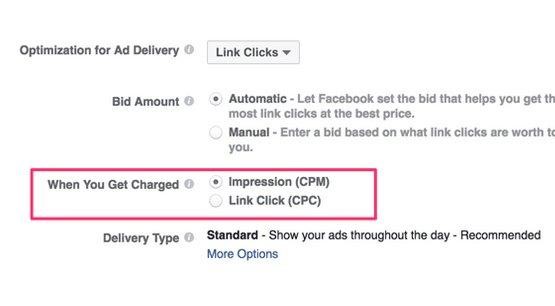
Although, if you have “reinforced concrete” information that the potential CTR will definitely be high, for example, 3-5%+, then you can safely use CPM.
Goals of AC on Instagram
The cost of a click on Instagram directly depends on the goals. Moreover, statistics show that some goals always go at more expensive prices. So in the first echelon, you can allocate brand promotion, lead generation and video viewing. And the first two goals are usually again needed by large brands, so the bet is justified. In the second price group we will find installations and conversions. And the cheapest will be sales and traffic. That’s why, by the way, affiliate marketing affiliates, as well as those who work in agency sales and in e-com, love this platform so much. Let’s just say it’s much easier and cheaper to promote an offer or sell a product on Instagram than to promote your brand or increase the popularity of your account. But the first is a single action, and a promoted brand or account will be able to make a profit in the long term. Therefore, here the pricing is quite adequate.
Time of posting on Instagram
There are exactly three general models that affect the price.
- season. That is, in principle, the time of the year or a specific month. Obviously, there will be more purchases on Christmas Eve, so the rate increases in the first months of winter;
- individual holidays. Again, it is clear that before major holidays or events (like Black Friday), the influx of buyers will grow. Advertising prices on Instagram will also go up;
- time inside the day. Usually the most expensive watches are evening ones. But depending on the target audience, they may change. If you are targeting an audience that is active in the morning or afternoon, then the bid will grow during this period. At the same time, your competitors will also choose their points to enter the market. And if you have identical ones, then you get into periods of increased competition, so you will have to fight financially for a click. It is worth balancing finely between points with high competition and points with low demand, so as not to overpay and not to lose customers.
The influence of ad relevance on the cost per click on Instagram
Yes, if you didn’t know, the more relevant your ad, creative, and AC in general are to the potential audience, the cheaper the price will be. Why? It’s simple, Instagram wants to create a positive experience for its users. This is beneficial both for the site and for advertisers. Therefore, it encourages ads that customers like. So that users are always shown the advertising they just need.
Instagram evaluates relevance in two ways:
- potential relevance. That is, the Instagram algorithms themselves reveal the thematic correspondence of the offer and targeting settings;
- statistical relevance. Instagram looks at the behavior of users who see your ad. What is the level of engagement, CTR, how much time they spend on viewing, and so on.
Niche competitiveness on Instagram
Increased competition does not directly affect the price of ads. And Instagram does not report data on such an impact anywhere. But they are analyzed from the accompanying factors. In the conditions of the same competitive sphere, all advertisers will have some similar moments in the settings. This is at least the goal, as well as the basic targeting settings. Therefore, advertising campaigns will fight for the same users. And since you can’t show them more advertising than Instagram allows, some advertisers will “fly by”. And these are exactly the ads that will offer a lower bid.
In principle, be prepared for increased competition, and hence the rates, if your proposal lies in the field of the most profitable niches for earnings in Insta:
- fashion;
- beauty and health;
- online education;
- sport;
- self-education;
- tourism;
- household goods;
- music and cinema;
- electronic goods;
- games and apps.
Betting on Instagram
Now let’s take a closer look at the very concept of betting on Instagram. The section is mainly for beginners. After all, there is no fundamental difference between the bid on Instagram and in any other social network, as well as in advertising networks.
Smart bid on Instagram
The simplest and most common model. Its attractiveness is based on the fact that 80% of advertisers on Instagram are actually either not professionals, or focus their competencies around other factors, do not study the principles of analysis.
In fact, Smart Bid independently adjusts the range of bids based on Instagram algorithms. This happens as follows: if the demand increases, and with it the supply, then the market at these hours simply fills up, becomes wider. And you can safely increase the size of the bids by a certain percentage in order to grab more customers. And if the supply has grown, but the demand has remained in the same place, then the situation is different. And then, in the battle for one client, a hundred advertisers will arrange such an auction that you can overpay $20-30 per click – a real situation. And at this moment the Smart bid will not increase the range.
In the opposite case, if competition falls, but demand increases, an automatic bidder can also reduce the range of bids in order to reduce the burden on the budget while maintaining an identical traffic flow. After all, the client will still be able to redeem even at a low price, there are a lot of them at this point in time.
Manual bets on Instagram
Here the range is set by the person himself. And he also regulates it himself in real time. What dangers immediately appear:
- you can just be late, it’s not time to track the market change. And either a massive chunk of traffic will be missed, or in the opposite situation, the budget will suffer;
- you can incorrectly set ranges, “play worse” than a Smart bid, eventually losing more money.
The choice is obvious, for a beginner or a person who does not want to engage in analysis – Smart bid, for an experienced professional with a significant amount of free time for monitoring – manual bids. Statistics say that a pro always works more efficiently than a Smart system.
Advertising from influencers on Instagram
Before that, we mainly talked about the cost of ads on Instagram through FB Ads Manager (or other promotional tools, the Advertising Center, for example). But the advertising opportunities of this social network do not end there. Ordering advertising from bloggers, famous and reputable personalities, celebrities is an effective practice. And such advertising also has its price.
You can’t talk about it as systematically as about ordinary paid ads. Yet each influencer declares its own price. And if many are really based on market indicators, competitors’ prices, as well as on the quality and quantity of their own audience, then others set the price literally at random. After all, a popular person on Instagram, alas, does not always know the basics of financial and economic science. Therefore, the pricing of such persons is often, let’s say, strange.
First of all, we recommend taking a closer look at microinfluencers. Among the advantages of working with them:
- loyal audience. She usually trusts her influencer more than on million-plus channels;
- adequate cost;
- normal communication. Yes, let’s clarify that agreeing on a deal on mutually beneficial terms with some pampered millionaires is not the easiest task.
As for the cost, compare the price offered by the influencer with the number of its audience. And you will see in general terms the relevance to the market or its absence. For example, if your ad can roll on Instagram at a price of $20 per thousand impressions, and a blogger offers advertising for $200 with an audience of 10 thousand active users, it is profitable. At the same time, even if the price of the influencer is 20-40% higher than Instagram offers, this is quite normal. After all, the native element works, the audience will trust their blogger more than faceless advertising from Instagram. Native is the trend of the latest tapes, which demonstrates enviable efficiency. But if you order such advertising, we recommend making sure exactly how the blogger will implement it. Sometimes influencers treat this task very “not caring”. And the final result will be far from your calculations. Therefore, before launching the ad, ask to show the final format.
Tips for optimizing your Instagram budget
So, now we have figured out in general terms what you will have to pay for on Instagram. We know which factors influence the cost of advertising, which increases the potential budget, which reduces. But how do we apply this knowledge? How not to overpay where you can save money? That’s what we’ll deal with now.
Budget settings and show schedule
This is the first and simplest stage. But for verification, it turns out to be almost the key. Because a good third of newcomers do not attach much importance to it, losing their budget in the most illogical way.
The budget allows you to set general restrictions for the campaign, as well as for a specific day period. Why do we need this? First of all, we clearly understand what expenses we will incur. And based on this, we are drawing up a strategy for further actions. Under no circumstances will we spend more than we planned. The tax service will not come to us, the warehouse will not light up, the outlet does not fall under the flood, as in the land business. There is only one danger – not to set a budget.
Then, if suddenly there is an influx of customers, all our money will be spent on advertising literally in one day. And what, is it bad, a beginner will ask? Very bad. Firstly, we will definitely lose extra money on competition. Secondly, most likely, having knocked out all the relevant audience, we will not go further along our target audience. Thirdly, AC often implies ― regularity. It will not be possible to pump out all the leads in a day, because most of them simply may not go online today.
The schedule of the show is also an important factor. It allows us to take advantage of our AC. If we have a strong creative, a powerful budget behind us, we can simply afford to enter the market during the most active hours and win. On the contrary, if the budget is small, and we are only testing creativity, then we need less active hours, where there is less traffic, but also competition is thinner. After all, we do not need to fight with the entire budget for every click or impression, we do not yet know how effective an offer, landing page, creative is. We’re just checking.
Analysis of AC results and optimization
Analytics is a stage that allows you to improve the effectiveness of your advertising campaign, as well as reduce budget expenditure while maintaining efficiency. The main thing is to be able to use existing tools competently.
In principle, the FB Ads Manager itself provides ample opportunities.
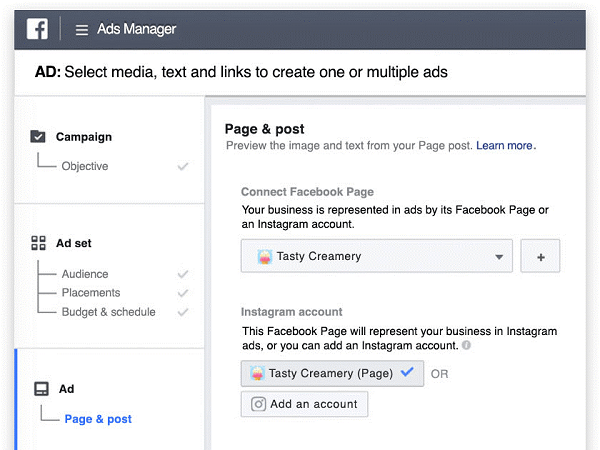
It allows you to conduct a qualitative analysis on a variety of positions. Determine the effectiveness of a specific advertising campaign or creative, look at the level of impressions, audience behavior, and consumption in each selected area. What can we get from this data? A lot of things, to find out which ads work better than others, in which time periods we get more benefits, and where we overpay for clicks. We will also get to know our target audience better, because we can clearly track which part of the traffic reacts more favorably to our offer.
Analytics is often divided into two types. The first is preliminary. We immediately identify our target audience, calculate the size of the budget, determine the targeting settings, the number of creatives, placement, and so on. The second one is optimizing, tracking. This is an opportunity to track the results of the campaign, get rid of problem areas, expand the most effective elements.
Of course, we can use not only the built-in tool from FB Ads Manager. Various advertisers often use their favorite trackers. But if in cases with other social networks (with the exception of FB), as well as advertising networks, this is a strict necessity, then for Instagram it is rather a whim. After all, FB Ads Manager has serious functionality that is quite suitable for a campaign with a budget of up to a thousand dollars daily. By the way, there’s a whole article on optimizing the RC in FB on our blog.
As an alternative, you can offer Sprout Social, which also has a very wide functionality.
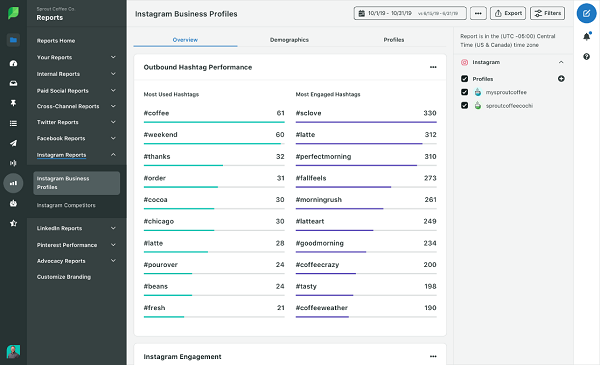
Or used for multiple Iconosquare advertising campaigns.
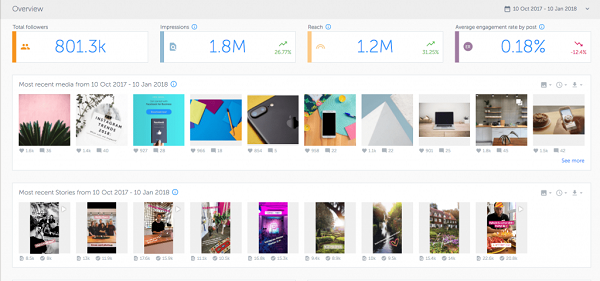
But if you are more used to FB Ads Manager at the same time, then it clearly makes little sense to retrain.
Increasing relevance, optimizing GEO and targer audience
So, we already understand approximately how it is possible to influence the price of ads on Instagram. After conducting the analysis, having analyzed the effectiveness of the AC from various points of view, through a variety of indicators, we will see the problem areas. It remains to fix them. And even if you have not identified problems with the help of analytics at first glance, like an advertising campaign works with the efficiency stated in the initial business plan, it can always be improved.
Here are the main optimization points that will positively affect the cost of ads on Instagram:
- Relevance of ads. As we said, Instagram lowers the bid price for the most relevant ads. That is, if we show users the advertising they need. And how to do it? First of all, competent targeting. So we do not impose our product on users, which is not the fact that they need. We are looking for those who are 100% interested in our product. It’s easy to track this moment, just look at the audience that clicks more often. If you note that 50% of all transitions were made by people from 25 to 26 years old, and the rest – from 26 to 46, then it becomes clear that the age targeting is set up incorrectly. We identify new narrower points, for example, 25-27 and 32-34, narrow down the search, but leave ourselves an identical number of clicks with much smaller impressions. Relevance increases by a level, the rate decreases. In addition, it is necessary to evaluate not only the relevance of the audience, but also our ads. If it turns out that out of 10 creatives in terms of one placement, we have more than half of the clicks converted by 3, then the remaining ones need to be either redone or simply deleted. Which will again increase CTR, which means Instagram’s favorability for our advertising campaign;
- Target Audience. At this point, you need to run through all the targeting settings again. And based on the analysis, evaluate the correctness of all points. From gender to age, from hobbies to place of work;
- GEO. One of the easiest parts of our optimization. Often, the tracker will clearly tell us which zones bring more traffic, which ones bring less. And we will also see which ones cost us more. The main thing is to keep the balance. If one of the zones carries a lot of traffic, but the average click there is more expensive, you should think about the conditions. If there are alternative zones, which in principle can cover all the needs of our Republic of Kazakhstan, if you transfer the budget to them – then it is worth doing so. But if, with the exception of expensive GEO, our total traffic volume drops significantly – this is bad. Either we are urgently looking for alternative zones, or we are expanding the demographic settings, or we are leaving an expensive zone (and what can we do).
Video about how much money you have to spend on advertising on Instagram
Example of basic analysis of AC for Instagram
There was a lot of theory in this review. And although we deliberately did not delve into the specific wilds of analysis so that the article was quite accessible to beginners, for many it will still be difficult to correlate all this data with the real situation. So let’s try to implement our new analytics skills using an applied example.
Let’s say we want to promote our own store, which is located not on a separate resource, but right inside Instagram. The functionality will not allow you to make purchases in normal mode, but we will process orders via WhatsApp.
What do we need first? Identify the cost and volume of production. Well, to simplify, our product will cost $5 (say, jewelry), and the selling price is $10. The cheat is still relatively small, but we will take it as a convention. The task of the initial advertising campaign on Instagram will be the implementation of 1000 units, with a total cost of $10,000. Taking into account the cost of production, we win $5000 (actually less if we take into account the costs, but again we omit this for the sake of clarity of the example).
So, in order to benefit, we must spend less than $5,000 on the AC.
We set the targeting settings, for example:
- age from 18 to 25 years (older people are unlikely to be interested in our cheap jewelry);
- we need secured customers, so we exhibit the main TIER 1 countries, USA, Canada, Germany, England, Netherlands, Australia, France;
- we specify the goal – sales by catalog or conversion;
- in the interests of specifying everything related to fashion and beauty, we also sell jewelry.
We create a AC with a dozen creatives prepared in advance, post them in a regular Instagram feed. We look at the market value of clicks on the selected parameters – $5, set the range to $4-7 (to get traffic during periods of competition).
We launch our AC – and lose all the money. Why? After all, we made several obvious mistakes.
Let’s be honest, if we are not a marketing guru, not a big brand, even a good offer will give us a maximum conversion rate of 3-4%. We will write off a couple more points for the cheapness of the goods, as well as for ingenious creativity, our limit is 5%. What happens if we pay an average of $5 per click, then we need 20 clicks for one guaranteed purchase. 20х5=$100<$10. We lost exactly 10 times. It was obvious that we didn’t need TIER 1 countries, it was much more logical to focus on TIER 2 or even TIER 3 traffic. Firstly, the price of the product suits them better, and secondly, the audience is much cheaper. If we were selling a diamond necklace, it is clear that we need a premium segment, but we sell cheap jewelry. We also missed the interests, so many popular tags on top topics increase the cost of a click. We only need a couple of interest tags, but more thematic for us. For example, «inexpensive jewelry».
As a result, by changing the GEO, reducing the number of settings in the interests and behavioral factor, we get to the average CPC of $0.1. And at 5% we get 20×0.1=$2<$10. It’s already better, though by changing the settings in this way, we will stumble upon a decrease in purchasing power. This means that our 5% conversion rate will drop to about 2%. And for a guaranteed purchase, we need 50 clicks already. 50х0.1=$5<$10.
Now everything is in its place. To sell 1000 units we need 1000x50x0.1=$5000. Congratulations, you went to 0, but you didn’t earn a cent, because $5000 was spent on the purchase of goods.
How to make a profit? And for this we need a trial period. That is, having calculated the settings at which we go to 0, we launch the AC with, say, $50 daily budget. And we check the statistics in a couple of days.
We see, for example:
- 1,3,5 converte creative, the rest not;
- Belarus and Ukraine are doing well, but Russia is spending money. Half of the regions of India give a lot of traffic, the rest just eat the budget at competitive rates;
- a lot of clicks do not reach the order after reading the purchase FAQ;
- we lose half of the budget in the evening because we don’t pull a competitive click.
Accordingly, we are changing our GEO, demolishing problematic creatives (adding new ones), improving the payment system, rewriting the FAQ, transferring the main budget for the day. In addition, customers often reach the purchase, plus to conversion, Instagram considers our ads relevant, minus to the cost of a click, changing the display schedule saves an extra $10 per day from the daily budget.
And now our AC is already starting to work in a plus. Yes, the example is purely schematic, in reality many more aspects will have to be taken into account. But the general mechanism of work has become clearer for the beginner.
Conclusion
Instagram – not the cheapest social network for an advertiser. But you’ll have to work with her anyway. The option to leave to competitors is not considered. After all, competitors simply cannot offer such an audience and functionality. Therefore, it is better to start learning. Practice claims that a competent professional with good analysis skills will be able to implement the same campaign twice cheaper than a beginner, without losing a grain of efficiency.

